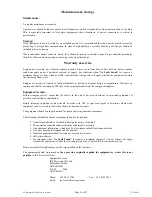
4230-mmm & 4230-mmx.ib.rev4.doc
Page 14 of 17
17/10/2007
SNMP
What Is It?
SNMP stands for Simple Network Management Protocol. It is an application layer protocol for managing IP
(Internet Protocol) based systems. SNMP enables system administrators to manage system performance, and to find
and solve system problems. SNMP runs over UDP (User Datagram Protocol), which in turn runs over IP.
Three types of SNMP exist: SNMP version 1 (SNMPv1), SNMP version 2 (SNMPv2) and SNMP version 3
(SNMPv3). It is not the intention here to discuss the differences between various versions, only to bring attention to
the fact that IRT Electronics modules, fitted with SNMP capability, use SNMPv1.
An SNMP managed network consists of three key components: Network Management Systems (
NMS
),
agents
, and
managed devices
.
An
NMS
is the console through which the network administrator performs network management functions, such as
monitoring status (e.g. alarm states) and remote controlling, of a set of managed devices. One or more
NMS
s must
exist on any managed network. Generally the
NMS
is a computer running third party SNMP control software. There
are a number of third party SNMP software applications currently available on the market.
An
NMS
polls, or communicates with, an
agent
. An
agent
is a network management software module that resides in
a
managed device
. An
agent
has local knowledge of management information and translates that information into a
form compatible with SNMP. The
agent
, therefore, acts as an interface between the
NMS
and the managed devices.
The
NMS
sends a request message, and control commands for the managed devices, to the
agent
, which in turn
sends a response message, containing information about the
managed devices
, back to the
NMS
.
A
managed device
contains an SNMP
agent
and resides on a managed network.
Managed devices
collect and store
management information and make this information available to
NMS
s using SNMP.
Managed device
agent
variables are organised in a tree structure known as a Management Information Base (
MIB
).
Within the
MIB
are parameters pertaining to the
managed device
. An Object Identifier (OID) number within the
MIB
defines the managed device type. This is a unique number specific to the model of
managed device
. Other
information relating to the device is also stored, information such as alarm states, controllable settings, etc. The
MIB
tree is organised in such a way that there will be no two
MIB
files with conflicting placements.
Normally an
NMS
polls an
agent
for information relating to the
MIB
in a managed device to be sent back to the
NMS
. When certain conditions are met within the
MIB
, such as major alarm conditions, for example, the
agent
automatically sends what is known as a
trap
to the
NMS
without any prompting from the
NMS
. This allows
automatic notification of a predetermined event.
NMS
NMS
IP
Network
MIB
SNMP Agent
Protocol Engine
SNMP Agent
MIB
SNMP Agent
Protocol Engine
SNMP Agent
MIB
SNMP Agent
Protocol Engine
SNMP Agent
SNMP Block Diagram









































